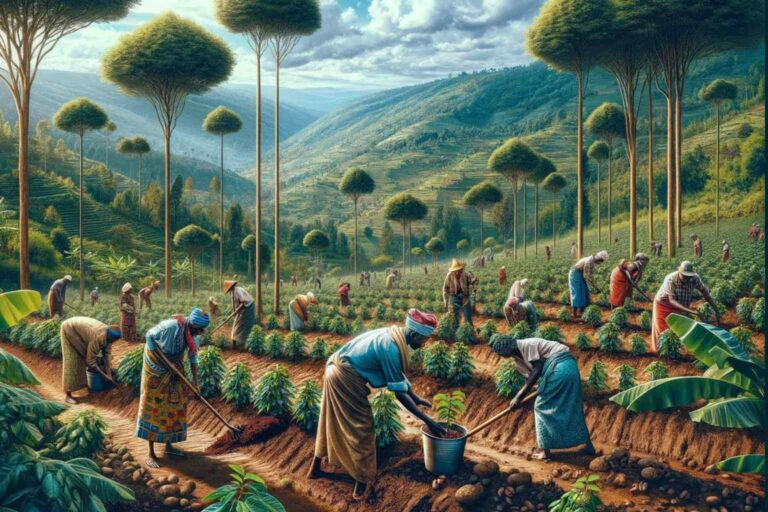
The Importance of Agroforestry: Introduction
Welcome to this week’s business education, where this week we take a look at the importance of agroforestry. In the Play It Green community passion for sustainability turns into real action for environmental restoration. Together, we tackle climate change with our three-step solution: reduce, repair, and regive.
This week, we focus on the “repair” part, taking a closer look at the significant contributions our amazing community makes. Together, we repair nature on land, coast, and sea. Today, we delve deeply into our agroforestry initiative in Rwanda. This practice not only aids in repairing the earth but also supports local communities economically.
In this article, we explore the broad social and environmental impacts of agroforestry. We show how this approach is crucial for creating a sustainable and resilient future.
The Importance of Agroforestry: What is Agroforestry?
Agroforestry is a sustainable land management approach that blends agriculture and forestry techniques. It aims to create diversified, productive, and sustainable land-use systems. At the core of agroforestry, we plant trees alongside crop fields and grazing lands. This strategic use of natural synergies between these different biological components boosts overall system productivity and resilience. In Rwanda, Play It Green supports agroforestry initiatives that transform landscapes into more resilient ecosystems. These systems can withstand climate changes and improve local biodiversity.

Agroforestry brings multiple ecological and economic benefits. By integrating trees into croplands and pastoral systems, farmers harness the ecological services trees provide. These include nitrogen fixation, microclimate stabilisation, and increased water infiltration into the soil. Trees also act as windbreaks, reducing soil erosion, and as living fences that secure crop fields. Moreover, the presence of diverse plant species within the same agricultural system promotes biodiversity. It provides habitats for various wildlife species, contributing to ecological balance and conservation.
The Importance of Agroforestry: Environmental Impacts of Agroforestry
Agroforestry significantly impacts the environment in diverse ways that contribute to both global environmental goals and local sustainability. One of the key benefits is carbon sequestration. Trees absorb carbon dioxide from the atmosphere, which is vital for mitigating global warming. The carbon is stored not only in the trees themselves but also in the soils under agroforestry systems. These soils often become richer in organic matter and more stable in their carbon storage capacity.
Agroforestry systems support a wider variety of plants and animals compared to conventional farming systems. The structural diversity provided by trees and different crop species creates various niches and habitats for wildlife. This increased biodiversity enhances ecosystem services such as pollination, pest control, and disease regulation. Consequently, it leads to more stable and productive agricultural systems.
Agroforestry practices also lead to better water management. The deep root systems of trees improve soil structure and increase the soil’s ability to absorb and hold water. This reduces runoff and soil erosion. Not only does it conserve water, but it also protects water quality by filtering out pollutants and preventing them from entering watercourses.

Such systems are particularly beneficial in areas prone to drought or where water resources are scarce. They provide a more resilient agricultural system against water-related stresses.
The Importance of Agroforestry: Social Impacts of Agroforestry
The social impacts of agroforestry are profound and transformative, especially in rural communities where agriculture is crucial. Agroforestry systems enhance food security by providing a more stable and diverse supply of food products. Trees yield fruits, nuts, and leaves, which people can consume or sell for income. This complements traditional crops and livestock, reducing the risk of food shortages and diversifying diets.
Furthermore, agroforestry provides economic benefits by integrating various production systems into a single practice. This diversification boosts the economic resilience of farming communities by offering multiple streams of income. Farmers harvest timber, fruit, fodder, and medicinal plants from the same areas where they grow crops or rear animals. This variety of produce buffers against the failure of any single crop due to pests, diseases, or fluctuating market prices.
It also enhances the overall economic stability of rural households. Community development is another critical aspect of agroforestry. These systems necessitate knowledge exchange and cooperative practices, such as shared water management and seed sharing. This creates stronger community relations and collaborative problem-solving.

Educational programs and workshops associated with agroforestry projects increase local capacities. They empower women and youth and promote sustainable development by building skills transferable to other agricultural innovations.
The Importance of Agroforestry: Wrap Up
The Play It Green community leads the way toward a more sustainable and resilient future by integrating agroforestry into their ecological and business practices. Through initiatives in Rwanda and elsewhere, we witness firsthand the benefits of this approach. It not only aids in landscape restoration and improved yields but also builds stronger, more sustainable communities.
We are immensely proud to be part of a community that is actively contributing to such transformative changes. Together, we are not just participants in this movement; we are pioneers, making real differences for our planet and for future generations.
Play It Green: Empowering Your Sustainability Journey
Ready to take your commitment to sustainability to the next level? Play It Green stands as your partner in creating positive environmental change. From educational resources on sustainable practices and signposting to sustainable services to initiatives like tree planting and social giving, Play It Green offers a holistic approach to environmental stewardship.
Join us in the journey toward sustainability—embrace eco-conscious practices and be a force for positive change in our world. All whilst staying relevant, meeting legislation and aligning with the values of today’s consumers and employees.






